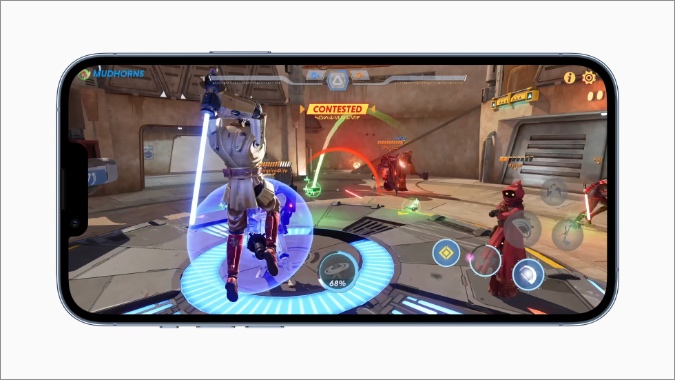After months of rumors and speculations, Apple officially took the wraps off iPhone 13 series. At first glance, it looks like the most prominent hardware upgrade to the iPhone lineup since the introduction of the iPhone X. Looking at the specs sheet and features list, we can’t help but draw a comparison with Android flagships already out there. Here are some of the best iPhone features that Apple took inspiration from and, in some cases, simply copied from Android flagships.
iPhone 13 Features Apple Copied from Android Flagships
Let’s start the list with the main highlight of the iPhone 13 Pro lineup – Display.
1. 120Hz Display
Android users don’t need an introduction to the 120Hz display. They have been enjoying higher refresh rate displays since the Razer phone days (does it ring the bell?).
As of now, almost all Android flagships and even mid-range phones offer a 120Hz display. iPhone 13 Pro lineup uses LTPO (low-temperature polycrystalline oxide), a low-power OLED screen that uses variable refresh rate.

Does it sound familiar? Yes, the Galaxy S21 Ultra and Xiaomi Mi 11 Ultra use the same technology. In a detailed iPhone 13 Pro tear down, we won’t be surprised to find Samsung as the sole manufacturer of high-refresh displays on the latest iPhone lineup.
The display can go as low as 10Hz and the iOS 15 adapts the refresh rate based on your scrolling speed and goes till 120hz. It’s identical to Galaxy S21 Ultra and the OnePlus 9 Pro.
In fact, Asus ROG 3 and ROG 3 Strix come with an even more impressive 144hz display. These smartphones were designed with gamers in mind.
2. 1TB Storage
Even though every company there wants users to utilize cloud storage to store app data and media, the in-built storage remains the de facto choice for consumers.
Apple now offers up to 1TB of storage on the iPhone 13 Pro Max. This is in line with many Android phones such as Galaxy S10+, Note 10+, and ZTE Axon 30 Ultra. The default iCloud storage remained capped at 5GB though.
3. Macro Photography
Once again this is something that many Android users are already exploring with flagship phones. Apple has integrated Macro photography with the Ultrawide lens.

The Android rivals like in the latest Oppo device bring dedicated Macro lens and phones like Galaxy S21 use large apertures to enable macro photography for close subjects on the phone.
4. Cinematic Mode in Video
Samsung revealed the Portrait video back in Galaxy Note 10 days. It completely blurs the video background while keeping the subject in focus. One can even change the intensity of the bokeh effect in video editing.
Apple is taking things further with Cinematic mode in video. It changes the focus in real-time delivering a cinematic style video viewing experience.

iPhone 13 Pro users can edit the same portrait effect in videos and create a professional-looking video right from the mobile.
5. Large Camera Aperture and Optical Zoom
In the camera hardware department, Apple is clearly playing catch up to the Android crowd. The iPhone 13 Pro packs f/1.5 aperture which is the same as LGV40 ThinQ back in 2019.
The Optical Zoom is also capped at 3x which is easily surpassed by Galaxy S21 Ultra’s lossless 10x zoom.
6. All Day Battery Life
Making a direct comparison to Galaxy S21 Ultra, the Samsung flagship already comes with one and a half to two days of battery life. Despite bigger battery, power-efficient A15, and iOS 15 advancements, Apple is only able to claim full-day battery life.
7. 1000 Nits Display Brightness
iPhone 12 Pro offered 800 nits of peak brightness during typical use. Apple bumped it to 1000 nits in the iPhone 13 Pro lineup. This is in line with a year-old Galaxy Note 20 Ultra’s 1000 nits display.
Wrapping Up: It’s All About Experience
Hardcore Android fans may dismiss iPhone 13 lineup improvements. But remember, it’s all about the experience. Have you ever seen Live Photo implementation on some of the Android phones? Have you tried Samsung’s portrait mode in videos? It’s laughable. Apple mostly focuses on end-user experience and waits for the component prices to come down.
It’s also one of the reasons that even after so many hardware improvements, Apple hasn’t hiked the prices on the iPhone 13 lineup.
When it comes to adopting new hardware technology, Apple has always been a latecomer to the table. Mostly, it’s due to the scale at which Apple operates, and other times, Apple doesn’t feel enough competitive pressure from the rivals to make the changes that quickly.
That being said, we feel Apple did miss the mark by excluding Always-on display, in-display fingerprint scanner, USB Type-C, and reverse wireless charging on the iPhone 13 lineup.